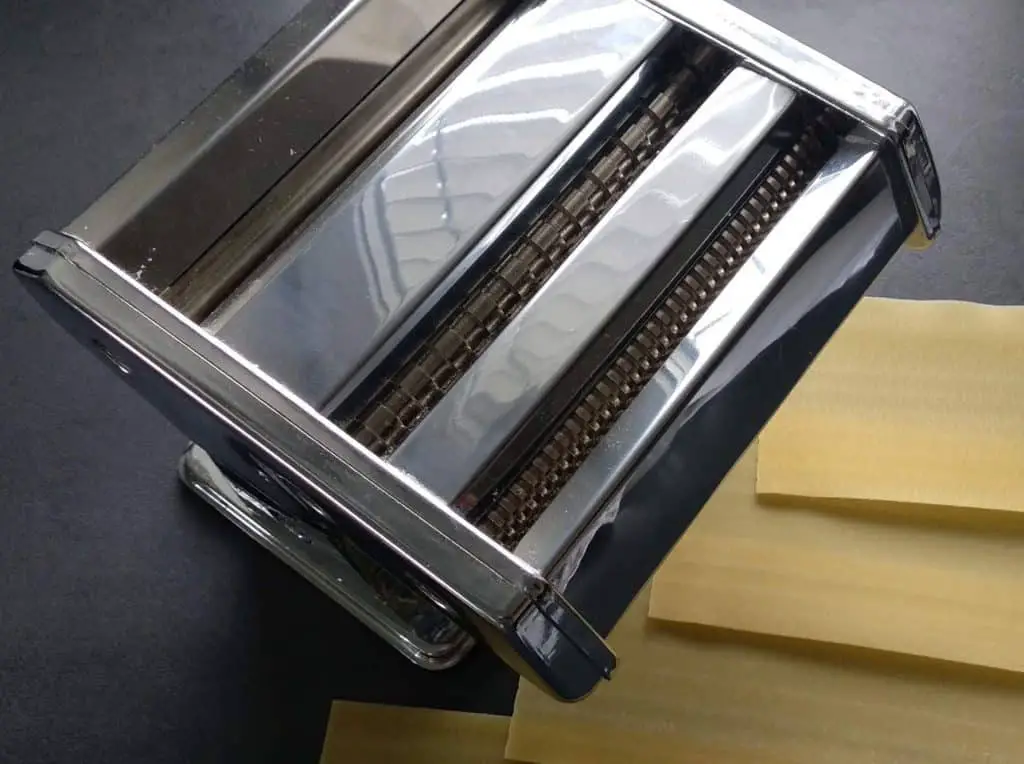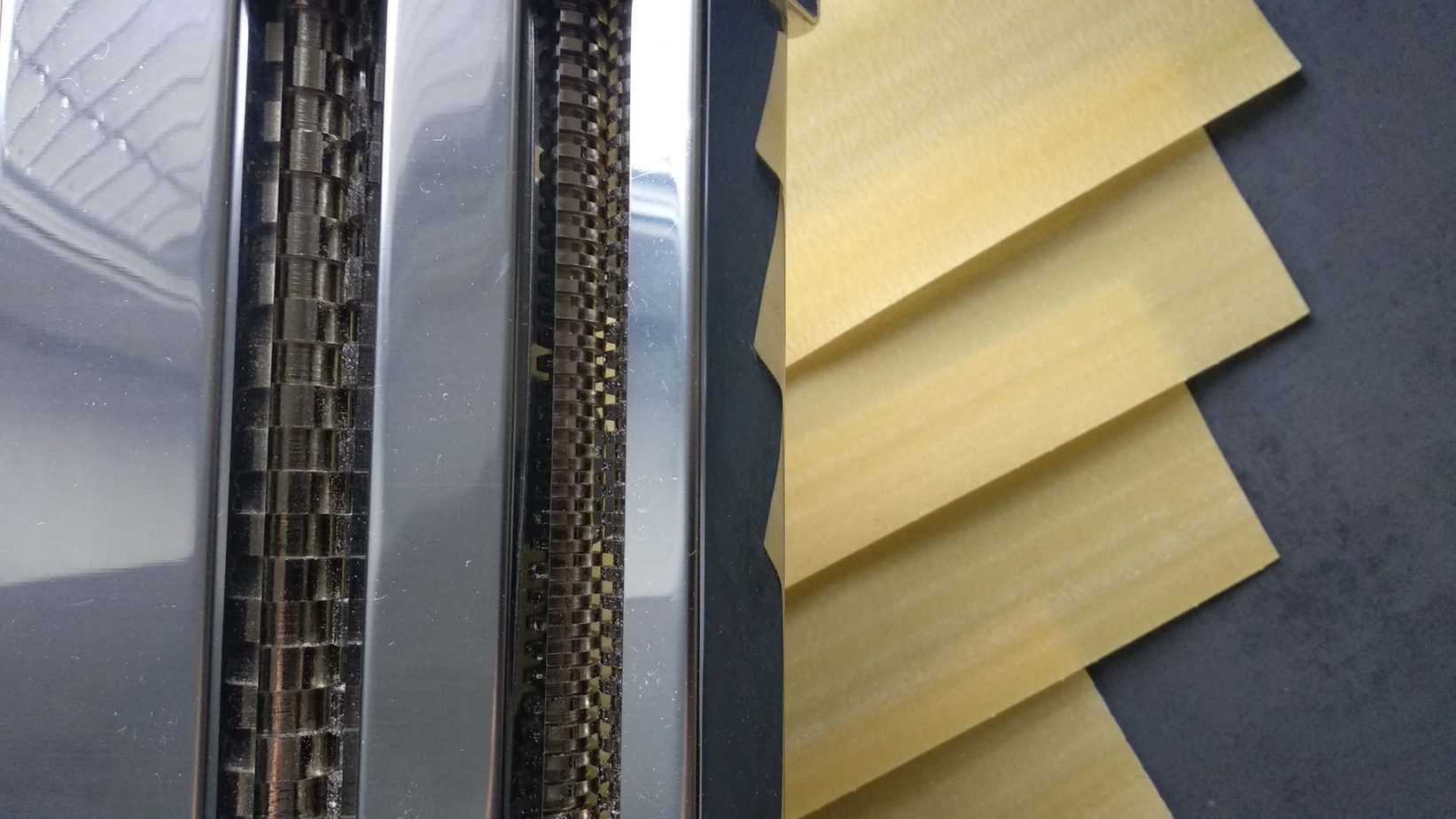When you are just starting on your homemade pasta journey and are still learning about the dough and the pasta cutter, eventually, you will ask
why my pasta machine is not cutting. I was wondering this same question and wrote about my discoveries.
Why is my pasta machine not cutting? Following are the 10 most useful solutions if your pasta machine is not cutting as it should.
the perfect cut:
1. The pasta dough is to wet
2. The pasta sheets are too wet
3. Cutters are dull or misaligned
4. Pasta sheets are too thick
5. The blades have a build-up of oil and moisture
6. Grip problem
7. Thickness setting
8. Gap problem between the rollers
9. Pasta dough is stuck between the cutters
My Pasta machine is not cutting, here is how to fix the problem
Wet pasta dough is the most common issue if your pasta machine is not cutting.
My discoveries showed me that the most common problem with pasta maker not cutting the dough properly is the wet dough. Of course, there might also be problems with pasta machine itself, but the too moist dough and pasta sheets issues are where you should start with.
If you are having problems with pasta machine not cutting properly, don’t give up, as it is worth spending time and money to learn to make
homemade pasta. You can check the cost and savings for homemade pasta in our other post, “Is It Cheaper To Make Your Own Pasta, Costs And Savings“.
1. The pasta dough is to wet
Basic pasta recipe calls for 1 egg and 100g of flour. There are, of course, other recipes that also include oil and water.
If your dough is too moist to cut, the first step is to reduce or altogether remove the moisture out of the recipe, except the egg.
When you start mixing the dough with just an egg, you might think the mixture is going to be too dry. To ease up the process of kneading,
home cooks usually add water or oil. We suggest you just give it time and knead it without adding any additional moisture.
In the kneading process, the moist will develop, and the dough will hydrate, although it doesn’t feel like it after the first minute of kneading. Never add more liquid if your dough is to wet in the cutting process.
If you make pasta with a recipe that includes water or oil, measure the quantities precisely. When the measurements are correct, and the dough is still too wet, there is a problem with the flour’s moisture. Reducing the amount of oil or water will result in dryer dough.
2. The pasta sheets are too wet
This is not the same as having a dough that is too wet. If pasta sheets are too wet, your pasta cutter might have a problem with cutting the sheets into the desired fettuccine or spaghetti shape. By following these two solutions, you can achieve proper cutting and sheets not sticking together:
– dust the pasta sheets with some flour. If pasta sheets are not floured well enough, the dough can stick much more quickly to the cutters, preventing them from cutting well. Flouring the pasta sheets also prevents them from sticking together, which can be quite annoying.
– dry the pasta sheets on the table. You might ask, how long should I dry pasta sheets? After the pasta sheets are rolled, they should always be dried for around 15 minutes.
If you dry pasta sheets for to little time, your pasta will be to wet and will stick on the cutters.
If you dry your pasta too long, pasta sheets will crack, and you will have problems with cutting the pasta into desired shapes. This is not so much of a cutting problem than the shaped problem because it is difficult to get long noodles if pasta sheets are too dry. By drying pasta too long, you will have the most issues with noodles or fettucini.
3. Cutters are dull or misaligned
It is not common that cutters get dull. Since you will only cut pasta dough with them, they really can’t get dull.
There might be a problem with the cutters’ misalignment, which can result in dough not being cut properly. If you are not sure, you can run a piece of paper through the cutters and see the result.
If the paper comes out in strips, the problem is not with cutters but rather with the pasta sheets (dry and/or flour the pasta sheets). If the paper isn’t cut properly and you think the problem is with dull cutters, you can always send the pasta maker back to the manufacturer. Since pasta cutters don’t cost a fortune, we always suggest you get a new pasta machine.
The best and most used pasta machine by home cooks on the market is either atlas 150 or kitchen aid pasta maker. Do not waste your time looking for the best one, we have already found it. You can buy it here on amazon.
- Marcato’s Original World-Famous Atlas 150 pasta machine rolls and cuts pasta dough for traditional lasagna, fettuccine, and tag at home
- Made in Italy from chrome-plated steel; Includes pasta machine, pasta cutter, hand crank, clamp, Instructions; 10-year
- Rolls sheets of dough to 150-millimeters wide at 10 thicknesses (0. 6 to 4. 8-Millimeter) for consistent texture, cook time, and taste.Atlas 150 is not dishwasher safe
- Easily attach the pasta drive motor and any of the 12 pasta cutting accessories (sold separately)
- Material Type: Nickel-Plated Steel, Chrome-Plated Steel, ABS
Last update on 2025-06-14 / Affiliate links / Images from Amazon Product Advertising API
4. Pasta sheets are too thick
It depends on what kind of pasta you are making but, if pasta sheets are thicker, they also need to dry longer before you cut them into desired shapes. Always try different thicknesses of sheets when you push them through the rollers and find the thickness that works best.

- Designed, engineered, and tested by KitchenAid
- Compatible with any KitchenAid Stand Mixer
- Attaches to multipurpose power hub
- All-metal housing
- Makes spaghetti and fettuccine noodles
Last update on 2025-06-14 / Affiliate links / Images from Amazon Product Advertising API
5. The blades have a build-up of oil and moisture
Some recipes include olive oil and water. If you add too much liquid, the dough will be sticky. You will be able to knead it more quickly and form a nice smooth dough, but when you roll the sheets through cutters, they might not cut all the way through. If you continuously make wet and oily dough, oil and moisture can build-up on the cutters. Moisture on cutters prevents the cutters from cutting properly. To avoid this, make dryer doug and wipe the cutters with a soft cloth to clean any excess moisture.
6. Grip problem
If the dough is not getting through the cutters because the rollers can’t get a grip on the dough, you should check the thickness setting.

7. Thickness setting
If the dough is not cut all the way through or cut properly and is still sticking together after it has gone through the cutters, try a different thickness setting. Sometimes pasta sheets can be too moist, and if they are too moist, you will have more problems with cutting, if the thickness setting is set on too thick.
8. Gap problem between the rollers
Check if there is a proper gap between both cutters. The cutters should overlap slightly, but you should see the light through in the middle where they come together.
9. Rollers are not turning correctly
it can happen that both rollers are not turning together. Make sure that both rollers are turning, one of them clockwise and the other counterclockwise.
10. Pasta dough is stuck between the cutters
Clean the pasta maker properly. Nobody likes cleaning the pasta maker. It is not something you put into a washing machine and forget about it. Pasta machine should never come into contact with water is it might rust. It is essential to clean the pasta machine regularly with a soft cloth by pushing it against the rollers and gently roll it.
What to do with pasta dough if all else fails
If all else fails, make some hand-cut fettuccini!
What to do with leftover pasta dough?
The easiest way to use leftover pasta dough is to grate it. You start by flattening your leftover pasta dough with your hands. Leave the pasta dough to dry for at least an hour. If you don’t leave it to dry, you won’t be able to grate it. When it is dry enough, take a box grater and grate the pasta dough on the thickest grater. When you are done, spread some parchment paper on a baking pan and spread the grated pasta dough evenly. Sprinkle some flour over, so it doesn’t stick and leave it to dry out completely. You can serve this with chicken soup or a broth.
What can I make with pasta dough scraps?
You can always re-roll pasta dough scraps and make a small batch of noodles. You can also save them and cook them together with the pasta
dish you are making. The shapes won’t be the same, but the taste will.



